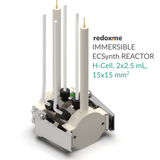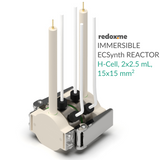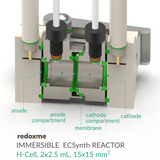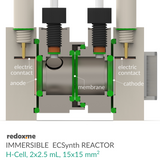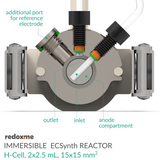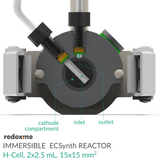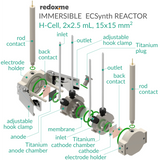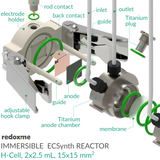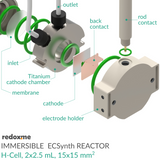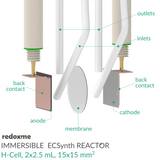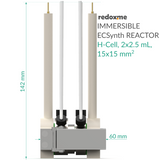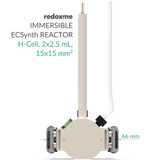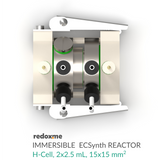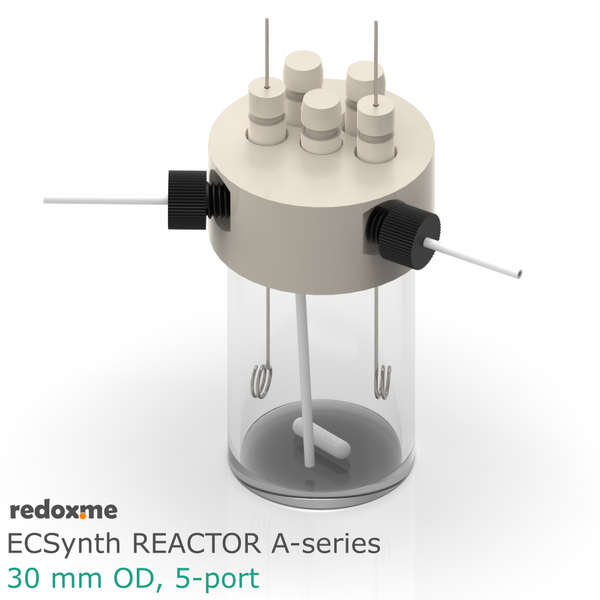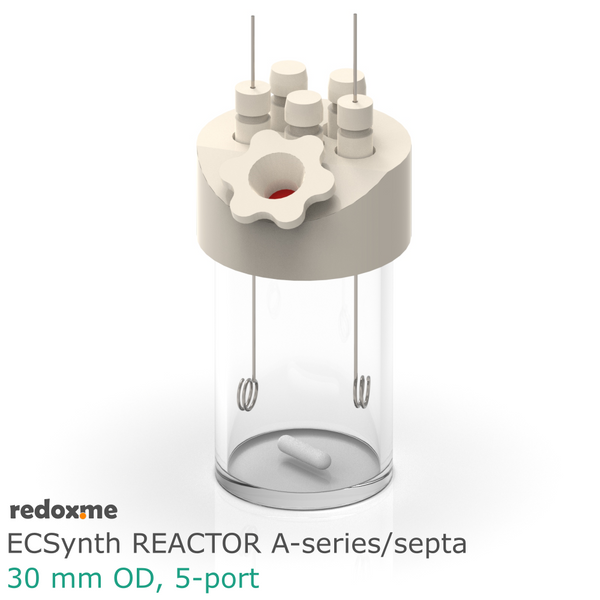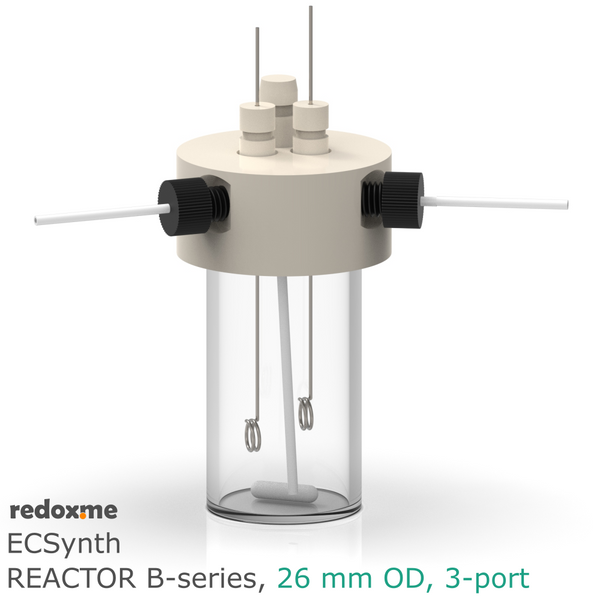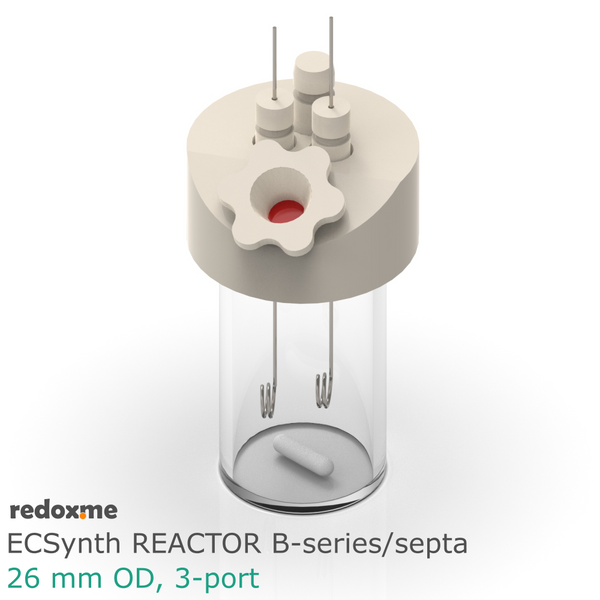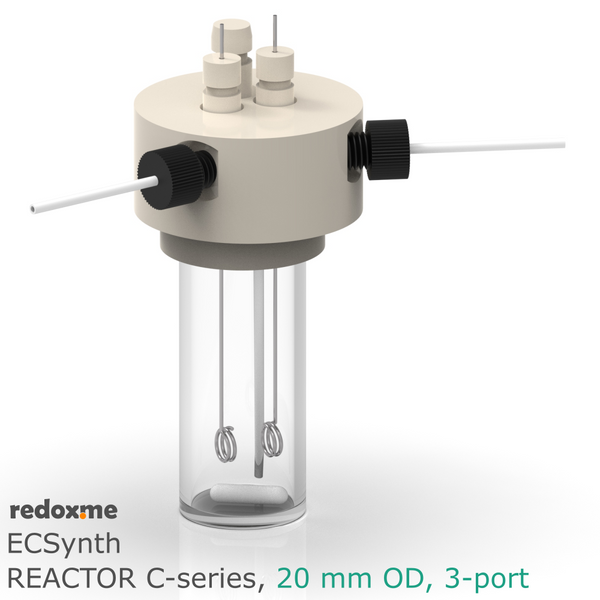Immersible Electrosynthesis Reactor, H-Cell, 2x1.5 mL, 15x15 mm2
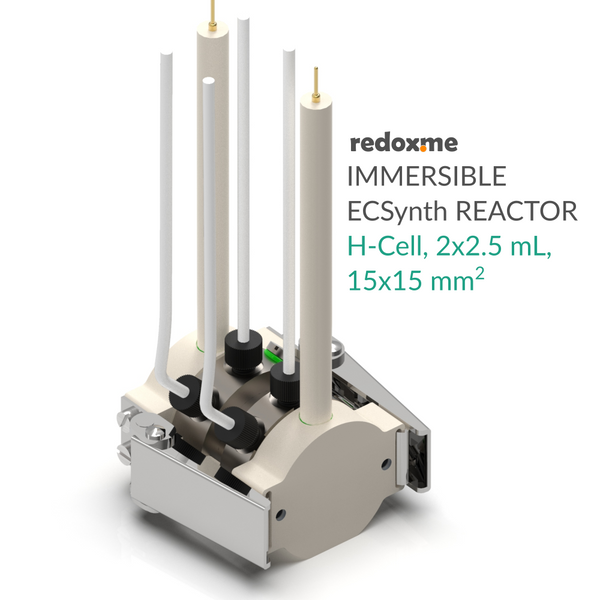
It is a two-compartment electrolytic flow cell designed specifically for electrosynthesis experiments. The whole cell can be immersed in a thermostatic bath to control the process temperature. Both chambers, are made of Titanium which ensures proper heat exchange while providing chemical resistance for a broad range of chemicals. Thanks to the application of adjustable hook clamps, the reactor can be easily assembled and disassembled within seconds.
The reactor consists mainly of the following elements: (i) Titanium anode chamber with inlet/outlet and additional electrode terminal (plugged when unused), (ii) Titanium cathode chamber with inlet/outlet, and (iii) two electrode holders with a back electrode contact and a rod contact to the external circuit. Both electrodes (not included in the setup) are in a form of a flat plate with dimensions of 15 mm x 15 mm x 0.5 mm each (other sizes are available on request). Due to the back-contact connection between current collector and the electrode, both electrodes should be made of a conductive material. Typically, Boron-Doped Diamond plate is used as an anode while Zirconium plate is used as a cathode. Other electrodes configurations include: Glassy Carbon Plates, Nobel Metal Plates (Platinum, Gold, Palladium and Silver), and other metal plates (Stainless Steel 316L/317L, Nickel, Titanium, etc.). The membrane is circular with a diameter in a range of 20 to 25 mm, and thickness up to 1 mm.
During the electrosynthesis process, the liquid electrolyte is circulated from the external thermoregulated reservoirs through both compartments separately. When the flow rate is sufficient, the flux hits the chamber wall and spreads evenly in the whole chamber volume providing proper mixing. The reacted liquid is then evacuated through the outlet located on the top of the chamber. In some cases, the reactor may also operate in a stagnant mode. The reactor elements that are in contact with the synthesized products are made of Titanium Grade 7. The seal is provided by O-Rings (FKM for aqueous synthesis and FFKM for organic synthesis). Other reactor elements that are in contact only with an external thermostatic bath are made of PEEK (electrodes holders and fittings), PTFE/FEP (tubbing), zinc plated steel (adjustable hook clamps). O-Rings exposed to the thermostatic bath are made of FKM. The construction is liquid tight. Operational temperatures lay in a range of -25 up to 200 deg C. The cell may be adopted to broader temperature range on request (-45 up to 300 deg).
Application note
Typical applications include a) electrochemical electrosynthesis in organic and aqueous electrolytes (anodic oxidation, cathodic reductions, redox reactions and electrofluorination), b) electrochemical waste-water treatment and c) electrochemical pre-treatment prior to biological processes. For troubleshooting instruction see the redox.me blog post
Specification
nominal electrode exposure area: 1 cm2 (11.3 mm dia.)
nominal membrane exposure area: 1 cm2 (11.3 mm dia.)
electrolyte volume: 2.5 mL/chamber
electrode distance: ~30 mm
additional electrode diameter: 6 mm
electrode size: 15 mm x 15 mm x 0.5
membrane size: 20 – 25 mm dia., <1 mm thick
chamber material: Titanium grade 7
maximum operational temperature: 200 deg C
minimum operational temperature: -20 deg C
tubbing size: 2 mm ID, 3 mm OD
Intrastat data
HS Code: 90309000
Country of Origin: Sweden
NET weight: 300g
Product includes
1 x Titanium anode compartment
1 x Titanium cathode compartment
1 x Titanium plug
2 x PEEK sample holder
2 x copper foil back-contact
2 x rod contact
2 x adjustable hook clamps
2 x guides
1 x set of O-rings
4 x flangeless nuts for gas inlet/outlet (3 mm OD tubing)
4 x flangeless ferrules (3 mm OD tubing)
Related products
Boron-Doped Diamond Plates
Noble Metal Plates
Glassy Carbon Plates
Membranes

